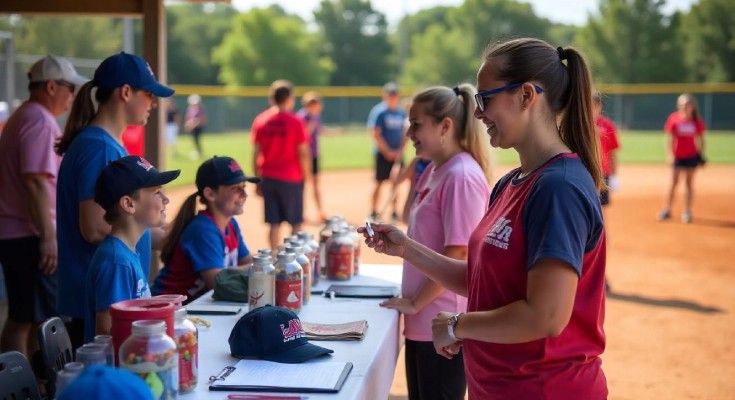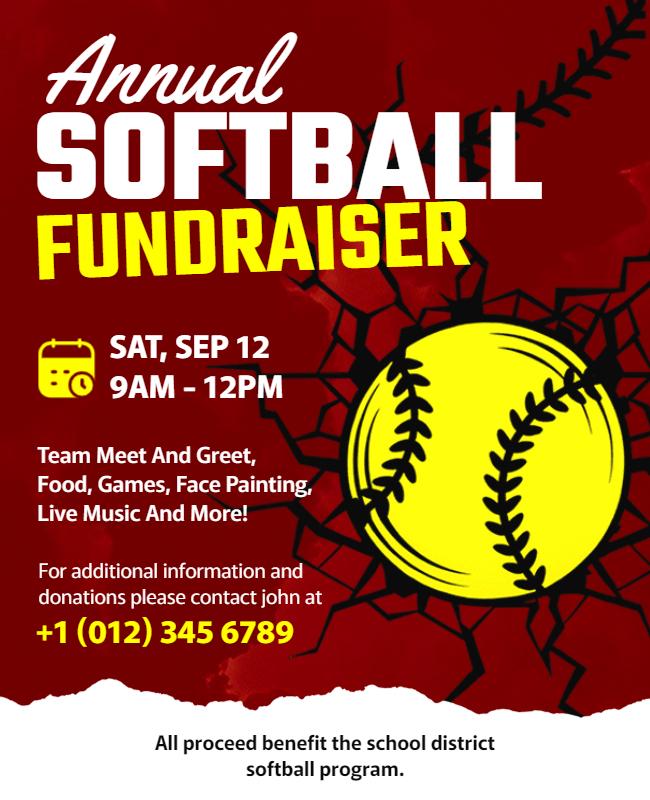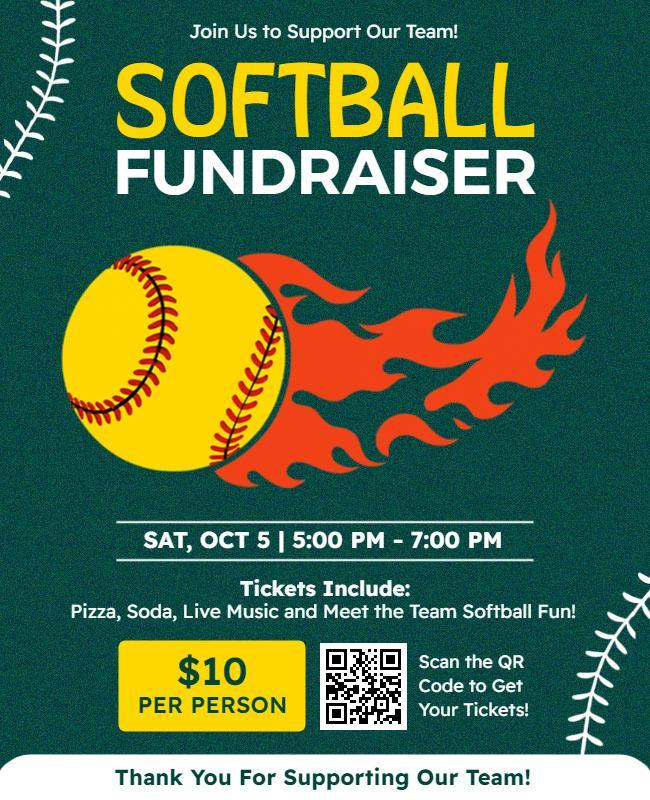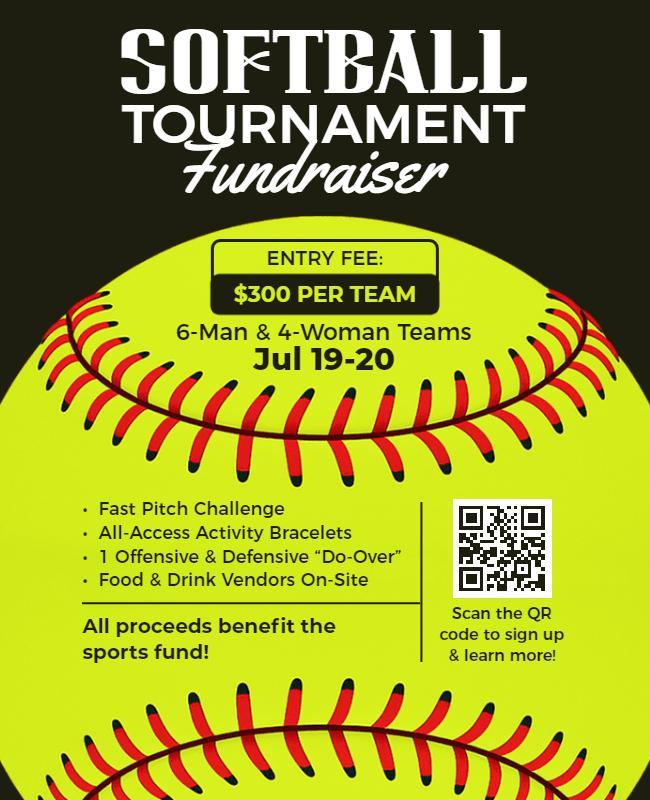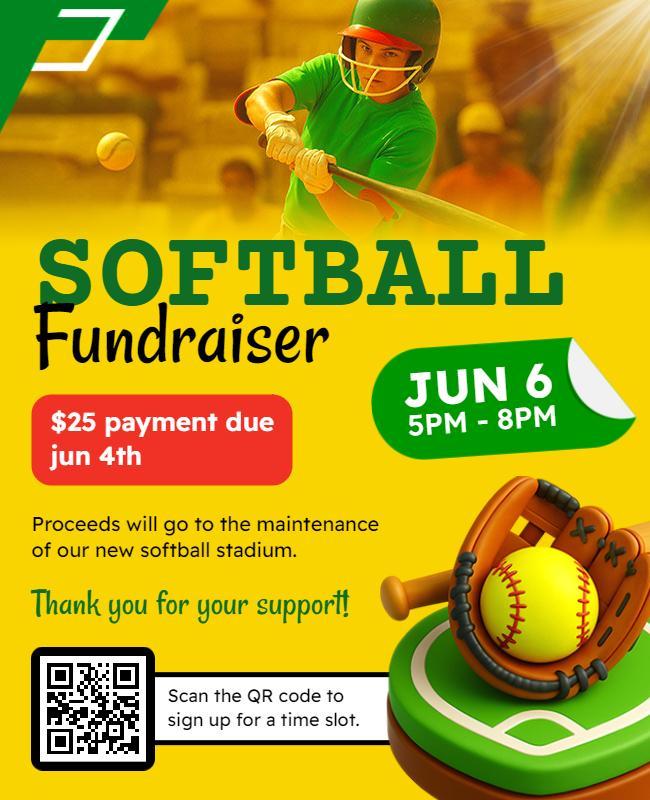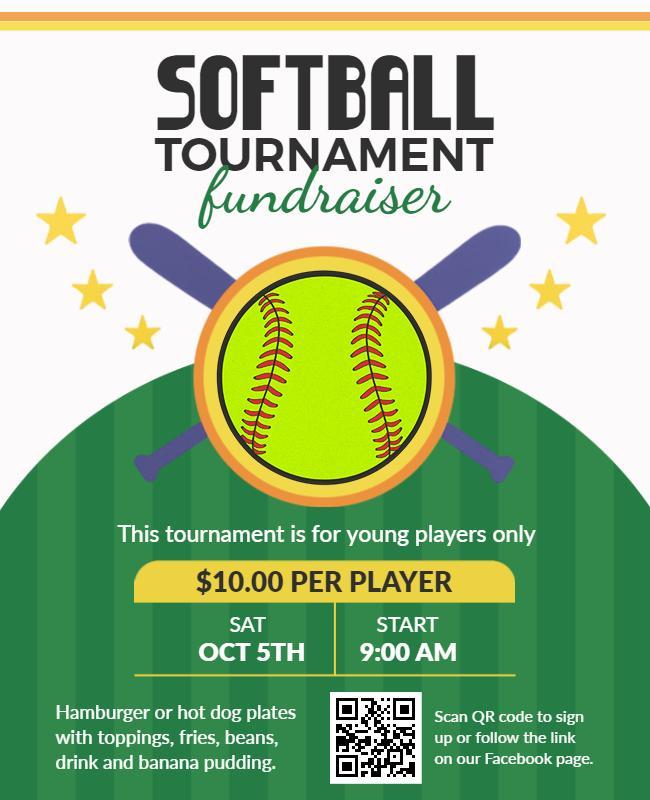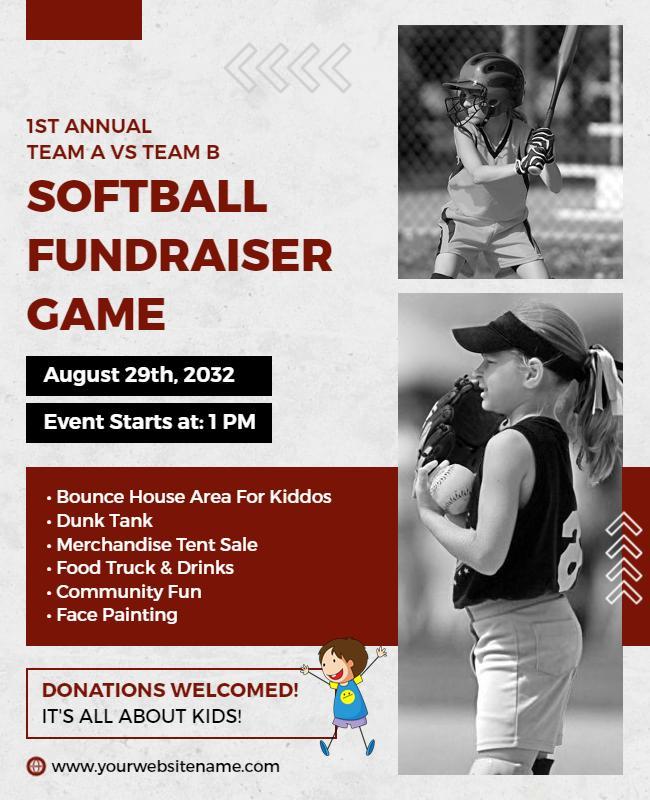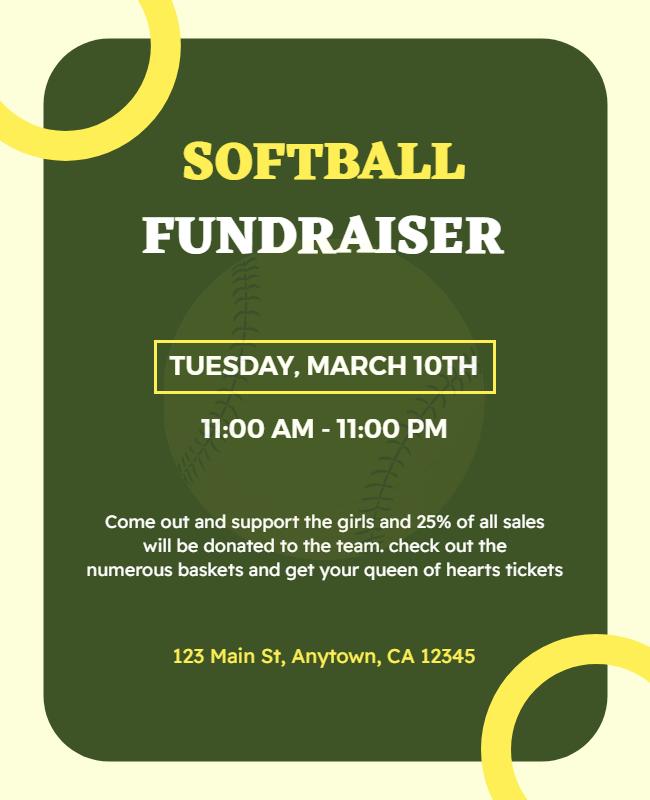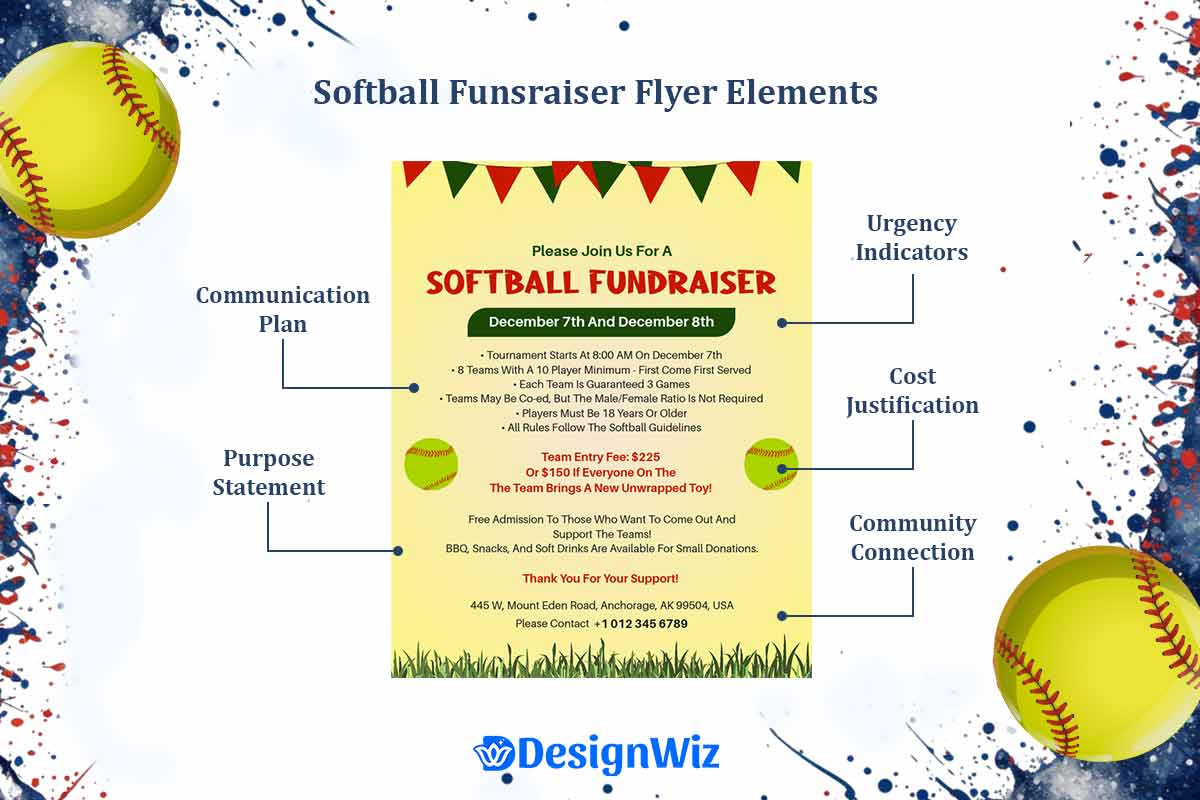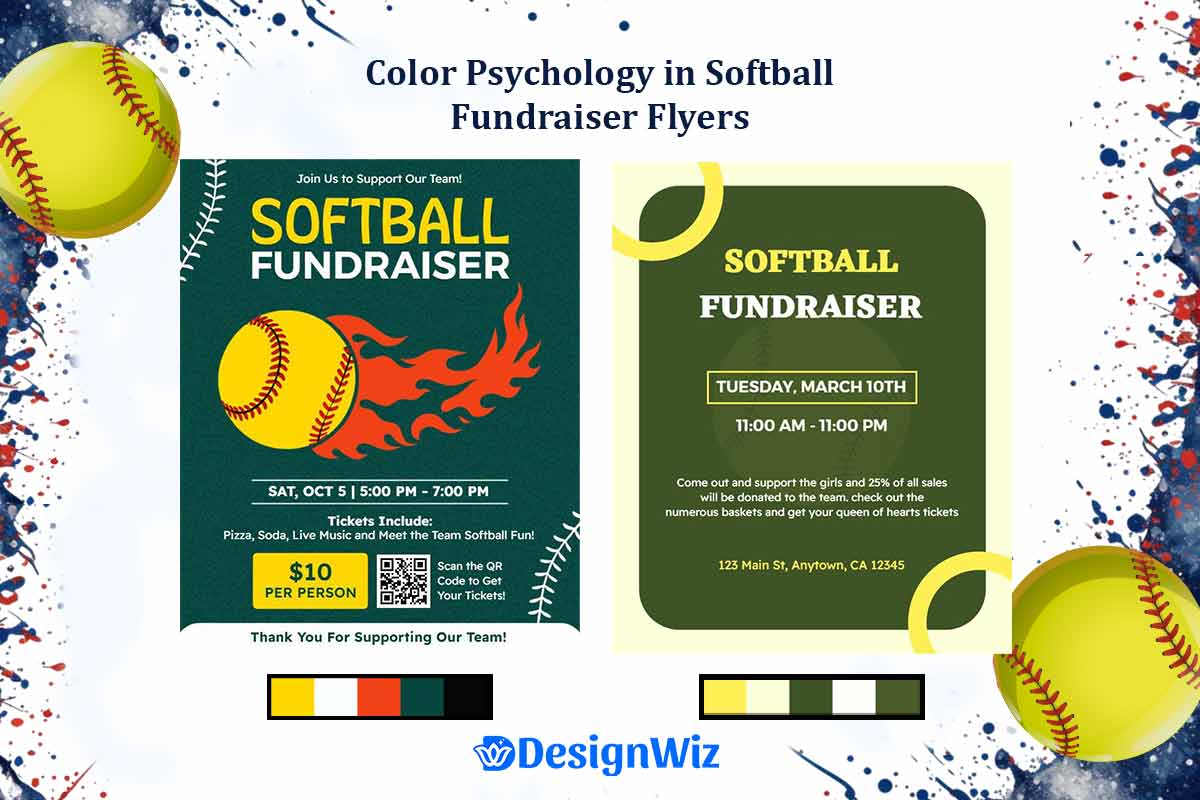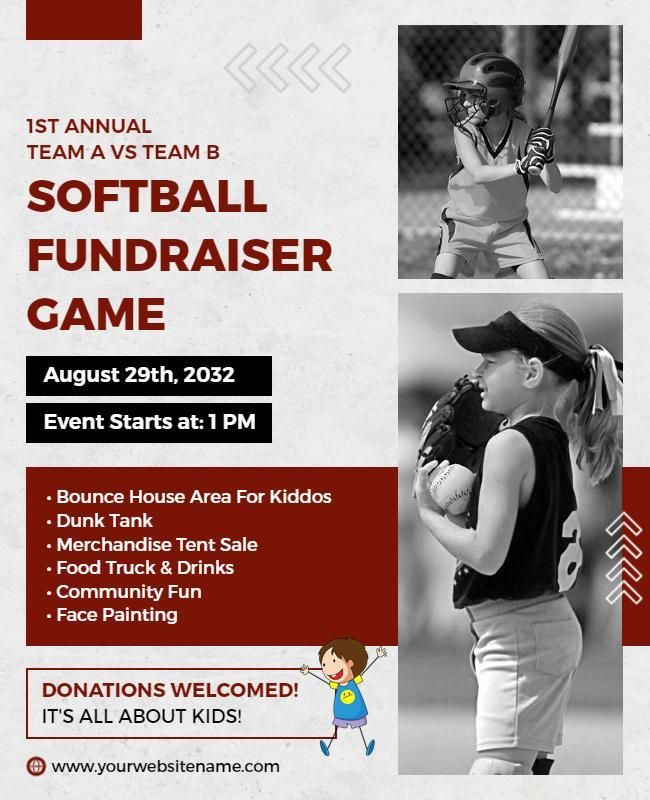Grab attention with editable flyer templates and smart design tips. Perfect for boosting turnout, raising funds, and rallying community support.
Let me be honest with you I’ve been in your shoes. Three years ago, I was desperately trying to raise $4,500 for our 12U travel team’s tournament fees, and our first fundraising flyer was a complete disaster. We raised $340 in six weeks. Parents were frustrated, kids were disappointed, and I was questioning whether I had any business organizing fundraising campaigns.
That failure taught me something crucial: Softball Fundraiser Flyers aren’t just about asking for money. They’re about creating emotional connections, building trust, and making people feel good about supporting your cause. The difference between a flyer that raises hundreds versus thousands isn’t luck it’s understanding donor psychology and implementing proven strategies.
Why Most Softball Fundraising Flyers Fail?
After working with over 80 youth sports teams on their fundraising campaigns, I’ve identified the four fatal mistakes that kill donations before they start:
- Generic Messaging That Doesn’t Connect Emotionally: “Please help our team raise money for equipment” tells donors nothing about why they should care. It’s selfish messaging that focuses on your need instead of their opportunity to make a difference.
- Unclear Fund Usage and Lack of Transparency: Donors want to know exactly where their money goes. “General team expenses” makes people suspicious. Specific breakdowns like “$150 pays for one tournament entry fee” build trust and confidence.
- Poor Timing and Donor Psychology Misunderstanding: Asking for money right after other major fundraising campaigns (school drives, holiday giving) means competing for already-stretched budgets. Understanding your community’s giving patterns is crucial.
- Weak Calls-to-Action That Don’t Motivate Giving: “Contact us if you’d like to donate” is passive and unclear. Effective fundraising flyers tell people exactly what to do next and make it easy to act immediately.
How Do You Create a Softball Fundraiser Flyer?
Creating softball flyers requires a completely different approach than promotional flyers. You’re not selling an experience you’re inviting people to invest in something bigger than themselves.
Step 1: Identify Your Emotional Hook
Before writing a single word, ask yourself: “Why should someone who has never met our players care about this fundraiser?” The answer becomes your emotional foundation.
Effective Emotional Hooks for Softball Fundraising:
- Community Investment Angle: “Help 15 local girls discover confidence through competitive softball.” This works because donors see their contribution as community development, not just sports equipment.
- Opportunity Creation Focus: “Give deserving athletes the chance to compete at the state championship level.” People love enabling opportunities that kids couldn’t access otherwise.
- Safety and Development Perspective: “Ensure our players have professional-grade protective equipment for safe skill development.” Safety resonates with parents and grandparents especially.
- Legacy and Tradition Building: “Continue our program’s 12-year tradition of developing scholarship athletes.” Donors want to be part of something established and successful.
Step 2: Define Specific Fund Usage with Complete Transparency
Donors have been burned by vague fundraising campaigns before. Transparency isn’t just ethical it’s strategic. Specific fund allocation builds trust and allows donors to connect emotionally with particular needs.
Fund Breakdown Strategies That Work:
Showing donors exactly where their contributions go builds trust this section breaks down typical softball fundraiser costs by category and amount.
Equipment-Specific Allocation:
- $75 = One protective helmet
- $150 = One quality bat for team use
- $300 = Complete catching gear set
- $500 = Team first aid and safety equipment
Tournament and Travel Breakdown:
- $200 = Tournament entry fee for entire team
- $400 = Team transportation to regional championship
- $100 = Two nights accommodation per player
- $50 = Tournament meal allowance per player
Facility and Long-term Investment:
- $1,000 = Dugout renovation and safety improvements
- $500 = Pitching mound professional maintenance
- $250 = Scoreboard repair and updating
- $100 = Field maintenance equipment
Paxton et al. (2020) found that nonprofits using positive emotional language experienced a 12–15% increase in donation rates and a 10% uplift in volunteer engagement, underscoring the value of transparent, emotionally resonant appeals in boosting support.1
Step 3: Create Donor Value Proposition
Successful fundraising answers the question: “What’s in it for me?” Donors need to understand the personal and community benefits of their contribution.
Donor Benefits to Highlight:
- Community Impact: “Your donation directly supports 15 local families and develops future community leaders through competitive athletics.”
- Tax Advantages: “All donations are tax-deductible (Tax ID: XXX-XX-XXXX). You’ll receive official receipts for tax filing purposes.”
- Recognition Opportunities: “Donors of $250+ receive permanent recognition on our team banner displayed at all home games.”
- Personal Connection: “Donors receive season updates with photos and achievements, so you can see exactly how your investment made a difference.”
According to the 2024 Donor Trust Report by BBB’s Give.org, 67.4% of U.S. adults rate “trust in charities” as essential (9–10 on a 10-point scale), yet only 22.1% actually give that high level of trust highlighting a crucial need for transparency and value-driven messaging in nonprofit outreach.2
Step 4: Structure Multiple Giving Levels for Accessibility
One-size-fits-all donation requests exclude potential supporters. Multiple giving levels ensure everyone can contribute meaningfully within their budget.
Proven Giving Level Structure:
- $25 – Team Supporter: Accessible entry level, covers small equipment needs
- $50 – Player Sponsor: Substantial but manageable for most budgets
- $100 – Game Changer: Significant impact, appeals to committed supporters
- $250 – Team Champion: Major supporter level with special recognition
- $500+ – Program Partner: Premium level for businesses and major donors
Alternative Contribution Options:
- Time Donation: Volunteer hours for team events and maintenance
- Service Provision: Local businesses offering supplies or services
- Facility Use: Venue donation for fundraising events
- Expertise Sharing: Professional services (accounting, marketing, photography)
Step 5: Design Clear Action Steps That Simplify Giving
The easier you make donation, the more money you’ll raise. Remove every possible barrier between donor interest and completed contribution.
Donation Method Optimization:
Making it easy to give is just as important as asking this section outlines the most effective donation methods to reach every type of supporter.
Online Giving (preferred by 65% of donors):
- Simple website link or QR code
- Mobile-optimized donation forms
- Immediate confirmation and receipt
- Recurring donation options
Traditional Methods (essential for older demographics):
- Check payments with clear mailing address
- Cash collection at games and events
- Phone donations with credit card processing
- In-person meetings for major gift discussions
Read More: Complete Guide to Softball Flyer Design: Expert Tips & Best Practices 2025
What Should You Include in a Softball Fundraiser Flyer?
After analyzing hundreds of successful and failed fundraising campaigns, I’ve identified the essential elements that must appear on every effective fundraising flyer.
Essential Information Checklist
Including the right details can make or break your fundraiser this section highlights the must-have information that builds trust, urgency, and emotional connection.
Fundraising Goal and Deadline:
- Specific dollar amount: “$8,500 needed by August 15th”
- Purpose statement: “Tournament travel and entry fees for fall season”
- Urgency indicators: “Registration deadline: August 20th”
- Progress tracking: “Currently raised: $3,200 (38% of goal)”
Fund Usage Transparency:
- Detailed breakdown: Percentages or dollar amounts for each expense category
- Cost justification: Why these expenses are necessary
- Benefit explanation: How fund usage directly helps players
- Accountability measures: How donors will receive updates
Team Story and Connection:
- Individual player spotlight: 2-3 players with personal stories
- Team achievement potential: Specific tournaments or opportunities
- Community connection: How team represents local area
- Program history: Years of operation, past successes, alumni achievements
Recognition and Stewardship:
- Donor acknowledgment methods: How supporters will be recognized
- Communication plan: Updates on progress and fund usage
- Impact reporting: How donors learn about results achieved
- Continuing relationship: Ongoing connection beyond immediate campaign
Trust-Building Elements That Increase Donations
Donors give more when they trust where their money is going this section highlights credibility boosters that reassure and motivate supporters.
Organization Legitimacy Indicators:
- Tax-exempt status: Clear display of 501(c)(3) status if applicable
- Tax ID number: For donor tax deduction purposes
- Board member contacts: Adult leadership contact information
- League affiliations: Official sanctioning body memberships
Financial Accountability Measures:
- Budget transparency: Complete expense breakdown
- Previous campaign results: Past fundraising success examples
- Fund management: Who handles money and oversight
- Reporting commitments: Specific update timeline for donors
Social Proof and Community Support:
- Endorsements: Local business or community leader statements
- Past donor testimonials: Previous supporters sharing their experience
- Media coverage: Local newspaper or social media features
- Volunteer involvement: Community members actively supporting team
According to Capraro et al. (2017), prompting individuals to reflect on moral norms before donating resulted in a 44 % increase in charitable contributions during a real‑world crowdfunding campaign, highlighting the power of trust‑building nudges in fundraising.3
Emotional Connection Strategies
Tapping into emotion can drive action this section shares ways to connect donors to your team’s stories, dreams, and broader community impact.
Player Spotlight Stories: Individual stories create personal connections that motivate giving. Feature players who represent your team’s diversity and values.
Example: “Sarah Martinez, 13, has been playing softball for 4 years. Her dream is to earn a college scholarship through athletics. Your donation helps provide the competitive experience colleges look for in recruiting.”
Team Achievement Potential: Connect donations to specific opportunities that wouldn’t exist otherwise.
Example: “This tournament features scouts from 12 colleges. Three of our alumni have earned softball scholarships after competing at this level.”
Community Impact Beyond Sports: Help donors understand how youth athletics benefits the entire community.
Example: “Young people who take part in competitive sports often grow into driven, goal-oriented adults many go on to pursue higher education and take on leadership roles in their communities.”
Read More: Softball Camp Flyer Design Guide: Attract More Participants This Season
What Are Proven Softball Fundraising Flyer Strategies?
Understanding donor psychology is the difference between campaigns that struggle to reach 30% of their goal and those that exceed 100% within weeks.
Donor Psychology and Motivation
Understanding what drives donors helps you speak their language this section explores the core motivations behind why people choose to support softball fundraisers.
What Actually Motivates Softball Fundraising Donors:
- Community Investment Mindset: Donors see their contribution as improving their community’s youth programs. They’re investing in local development, not just sports equipment.
- Nostalgia and Personal Connection: Many donors played sports themselves or have children who benefit from youth athletics. They understand the value personally.
- Tangible Impact Preference: Donors want to see specific results from their contribution. “Your $100 bought two batting helmets” is more satisfying than “Your $100 helped our general fund.”
- Social Recognition Desire: While not everyone admits it, recognition motivates many donors. Public acknowledgment of their generosity provides social value for their contribution.
- Tax Benefit Appreciation: Especially for larger donations, tax deductibility can be the deciding factor between giving and not giving.
According to GlobalGiving, reframing donation appeals as part of “completing a set” (e.g., contributing to different regions or themes) significantly increases donor motivation, and contributions that help an appeal reach its goal are, on average, 200% larger than earlier donations illustrating powerful psychological drivers for giving.4
Successful Fundraising Campaign Types
Different fundraising goals call for different strategies this section highlights the most successful campaign types and the design elements that make them effective.
Equipment Replacement and Upgrade Campaigns
These campaigns work because donors can visualize exactly what their money purchases. Safety equipment especially resonates with parent and grandparent donors.
Example Success: Wilson Park Softball raised $6,200 in 5 weeks for new helmets and protective gear by emphasizing safety improvements and showing before/after photos of worn equipment.
- Before/after photos of current vs needed equipment
- Safety statistics about proper equipment
- Cost breakdown per item with donor recognition levels
- Timeline urgency related to season start
Tournament Travel and Opportunity Campaigns
These focus on experiences and opportunities that players couldn’t access without donor support. They appeal to donors who value education and personal development.
Example Success: Metro Fastpitch raised $12,800 for nationals travel by highlighting college recruitment opportunities and featuring alumni success stories.
Design Elements That Work:
- Tournament prestige and competition level explanation
- College recruitment and scholarship potential
- Player testimonials about past tournament experiences
- Detailed expense breakdown showing value for money
Facility Improvement and Infrastructure Campaigns
Long-term improvements appeal to donors who want lasting community impact. These campaigns often attract larger donations from businesses and established community members.
Example Success: Riverside Softball Association raised $28,000 for field improvements by emphasizing community benefit and offering naming opportunities.
Design Elements That Work:
- Before/after facility renderings or photos
- Community use and benefit explanation
- Naming and permanent recognition opportunities
- Multi-year impact and legacy messaging
Timing and Distribution Strategy That Maximizes Results
Timing matters just as much as messaging this section outlines when and how to launch your softball fundraiser for the best possible response.
Optimal Fundraising Seasons Based on Community Giving Patterns:
- Early Spring (March-April): Tax refund season when families have extra disposable income. Avoid overlap with school fundraising campaigns.
- Late Spring/Early Summer (May-June): Post-holiday recovery period when people are ready to support community causes again.
- Late Summer (August-September): Back-to-school season when parents are thinking about their children’s activities and development.
Avoid These Periods:
- December-January: Holiday spending and post-holiday budget recovery
- September-October: School fundraising peak season
- July: Vacation season when people are focused on travel and family time
Multi-Touch Distribution Approach:
- Initial Introduction (Week 1): Soft introduction to campaign with team story and general need
- Detailed Case (Week 2-3): Full fundraising materials with specific goals and deadlines
- Progress Update (Week 4): Current status and remaining need with social proof
- Final Push (Week 5-6): Urgency messaging and last opportunity appeals
Read More: How to Create Softball Tryout Flyer That Attract the Best Players
How Do You Choose Colors for Fundraising Flyers?
Color psychology in fundraising materials directly impacts donor trust and giving behavior. The wrong colors can undermine credibility, while the right combinations increase perceived legitimacy and emotional connection.
Trust-Building Color Psychology
The right timing and delivery plan can turn a good fundraiser into a great one align your efforts with giving patterns and keep supporters connected at every stage.
Primary Trust Colors for Fundraising:
- Navy Blue: Navy blue is often seen as a trustworthy and dependable color, which is why it’s commonly used in professional and fundraising flyers to create a sense of confidence and reliability.
- Forest Green: Suggests growth, prosperity, and environmental stewardship. Particularly effective for community-focused campaigns.
- Deep Purple: Communicates dignity, quality, and respect. Works well for scholarship and educational opportunity fundraising.
- Burgundy: Indicates sophistication and established authority. Effective for programs with long community history.
Emotional Response Colors That Motivate Action
Maximize your fundraiser’s impact by launching when donors are most receptive and keeping interest high with a well-timed rollout.
Secondary Accent Colors:
- Gold/Yellow: Creates optimism and energy while maintaining professional appearance. Use sparingly as accent color.
- Silver/Gray: Provides balance and neutrality while supporting main trust colors.
- Warm Red: Generates urgency and passion but can feel aggressive in fundraising. Use only for deadline urgency.
- Orange: Conveys enthusiasm and friendliness but may appear too casual for serious fundraising.
Proven Color Combinations
Choose colors with purpose these tested combinations not only look great but also reinforce trust, professionalism, and emotional appeal in your Softball fundraiser flyer.
- Navy + Gold: Professional fundraising campaigns, particularly for competitive teams and major equipment purchases.
- Forest Green + Silver: Community-focused campaigns, facility improvements, and environmental stewardship messaging.
- Purple + White: Scholarship funds, educational opportunities, and dignity-focused campaigns.
- Team Colors + Trust Accent: Maintains brand consistency while adding credibility through trust color integration.
What Size Works Best for Softball Fundraiser Flyers?
Size selection for fundraising materials requires balancing visibility, cost, and distribution method effectiveness.
Distribution Method Optimization
Make every flyer count by matching its format to how it’s shared these optimized distribution methods help your message reach the right people, in the right way.
- Door-to-Door and Hand Distribution: 5.5″ x 8.5″ half-sheet size works best. Easy to handle, fits in standard folders, and recipients are more likely to keep smaller pieces.
- Community Bulletin Board Posting: 8.5″ x 11″ standard letter size ensures visibility among other posted materials while fitting standard cork boards and display cases.
- Mailing Campaigns: 8.5″ x 11″ folds efficiently into standard business envelopes. Consider tri-fold design for self-mailing capabilities.
- Digital Sharing and Social Media: Square format (1080×1080 pixels) optimizes for Facebook and Instagram sharing. Vertical format (1080×1350) works well for Instagram stories.
Budget Considerations for Fundraising Materials
Stretch every dollar without sacrificing impact these budget-friendly strategies help you produce effective Softball Fundraiser flyers that look professional and stay within financial limits.
- Half-Sheet Printing Strategy: Print two flyers per 8.5″ x 11″ sheet, reducing paper costs by 50% while maintaining professional appearance.
- Bulk Printing Discounts: 500+ copies typically qualify for offset printing discounts. Calculate break-even point between digital and offset printing.
- Quality vs Quantity Balance: Higher quality paper stock (24lb vs 20lb) increases perceived legitimacy and donor confidence. Consider premium paper for major campaigns.
- Digital-First Approach: Design for digital distribution first, then adapt for print. Saves initial costs while maintaining flexibility.
Read More: Softball Tournament Flyer Design: Complete Promotion Guide
How Do You Promote Softball Fundraising Events Effectively?
Successful fundraising extends beyond Softball Fundraiser Flyer distribution to comprehensive community engagement and relationship building.
Multi-Channel Distribution Strategy
Expand your reach and boost visibility by combining community partnerships with digital outreach this strategy gets your fundraiser in front of more supporters, faster.
Community Partnership Development:
- Local Business Relationships: Partner with businesses that serve families (restaurants, retail stores, service providers) for flyer display and cross-promotion opportunities.
- School and Youth Organization Networks: Coordinate with other youth programs for mutual support and shared distribution opportunities.
- Religious and Community Center Connections: Leverage existing community gathering places for bulletin board posting and event announcements.
- Sports League Collaborations: Partner with other athletic programs for joint fundraising events and shared donor cultivation.
Digital Amplification Strategies:
- Team Social Media Optimization: Create shareable content that parents and supporters can easily distribute through their personal networks.
- Community Facebook Group Engagement: Participate authentically in local community groups with appropriate fundraising messaging.
- Email Campaign Sequencing: Develop multi-touch email campaigns with different messaging for each contact.
- Local Media Outreach: Pitch human interest stories to local newspapers and radio stations for earned media coverage.
Event Integration and Community Engagement
Turn everyday events into fundraising opportunities by weaving your message into game days, parent meetings, and local community gatherings.
Game Day Fundraising Integration:
- Between-innings announcements with specific fundraising updates
- Donation collection during concession stand operations
- Program inserts with fundraising information
- Parent meeting integration with dedicated fundraising discussion time
Community Event Participation:
- Local fair and festival booth presence with fundraising materials
- Restaurant partnership nights with percentage donation agreements
- Community service projects that build goodwill and awareness
- Seasonal events (holiday tournaments, summer camps) with fundraising components
Hall et al. (2013) found that local donors strongly favor fundraising tactics that foster community connection. Specifically, events encouraging participation like workplace-giving drives and local media partnerships were preferred, while guilt‑inducing methods and telemarketing were not.5
Follow-Up and Donor Stewardship
Securing donations is just the start thoughtful follow-up and consistent updates turn one-time gifts into long-term support.
Immediate Acknowledgment Systems:
- Thank you communications within 24 hours of donation receipt
- Official tax receipts with professional formatting and clear tax information
- Social media recognition (with donor permission) highlighting contributions
- Personal phone calls or handwritten notes for major donors
Progress Communication Strategy:
- Weekly update emails showing fundraising progress toward goal
- Photo documentation of fund usage (equipment purchases, tournament participation)
- Season summary reports showing specific achievements enabled by donations
- Annual recognition events celebrating donor contributions and team success
Softball Fundraiser Flyer Design Inspiration Gallery
Our flyer templates are designed with proven layout strategies and attention-grabbing visuals to support team fundraising success. Each template is fully customizable to your event details, team colors, and fundraising goals.
Ready to create a flyer that helps your team raise more? Check our collection of softball fundraiser flyer templates built for bake sales, car washes, raffles, and more.
Here’s a curated selection of softball fundraiser flyer designs to inspire your own creation. Each links to a full preview page with customization options:
- Softball Fundraiser Event Invitation Flyer
- Softball Fundraiser Event Flyer
- Community Softball Fundraiser Game Flyer
- Dynamic Softball Tournament Fundraiser Event Flyer
- Community Softball Fundraiser Event Flyer
- Youth Sports Green Softball Fundraiser Event Flyer
- Flaming Softball Community Fundraiser Event Flyer
FAQs About Softball Fundraiser Flyers
Research your community’s economic demographics first. Successful campaigns offer multiple levels: $25 (accessible entry), $100 (substantial contribution), $250 (major supporter), $500+ (sponsor level). Most donations fall in the $50-150 range, but offering higher levels captures major donors.
Include your organization’s tax-exempt status (if applicable), complete contact information, and transparent fund usage disclosure. Check local regulations for nonprofit solicitation requirements. Consider legal review for campaigns over $10,000 or involving business partnerships.
Begin planning 8-10 weeks before you need funds. Allow 2-3 weeks for design and material preparation, 4-5 weeks for active solicitation, and 1-2 weeks for follow-up and final collection. Earlier planning reduces pressure and improves results.
Individual stories create stronger emotional connections and higher donation rates. Feature 2-3 diverse players per campaign, rotating spotlights across team members. Balance personal stories with team achievement goals for maximum impact.
Differentiate through specific impact messaging and community connection rather than competing directly. Emphasize your unique value: local investment, youth development, specific opportunities. Coordinate timing with other organizations when possible.
Use unique tracking methods for different distribution channels: specific phone numbers, email addresses, or online donation codes. Monitor response rates, donation amounts, and donor retention by source. This data improves future campaign planning.
Template designs can be reused, but messaging must be specific to each campaign’s goal, timeline, and target amount. Generic fundraising messages perform 60% worse than campaign-specific materials. Customize content while maintaining visual consistency.
Always include smaller donation options ($10-25) and non-monetary support opportunities like volunteering, social media sharing, or service provision. Every contribution builds community support and may lead to larger future donations.
Yes. Digital versions need higher contrast for screen viewing, clickable donation links, and mobile optimization. Print versions require careful color reproduction consideration and professional paper quality to build credibility and trust.
Focusing on organizational need instead of donor opportunity. Effective flyers emphasize community impact, youth development benefits, and donor recognition rather than just “we need money.” Shift from “Help us” to “Join us in supporting these amazing kids.”
People Also Ask
The secret is emotional storytelling combined with visual impact. Show specific players’ dreams, include before/after photos of team improvements, and use powerful headlines like “Help Sarah Get to State Championships.” Add urgency with limited-time matching gift offers or countdown elements.
Create responsive designs with scalable fonts, high-contrast colors, and mobile-optimized layouts. Include both QR codes for digital donations and traditional contact information. Test readability on phones, tablets, and printed materials to ensure consistent effectiveness across all platforms.
Burying the donation ask in tiny text or making it complicated to give. The call-to-action should be the most prominent element with clear, simple instructions. “Text DONATE to 555-0123” works better than paragraph explanations of donation processes.
Conclusion: Transform Your Fundraising Results
Creating effective Softball Fundraiser Flyers isn’t just about design it’s about understanding human psychology, building trust, and making donor participation feel meaningful and rewarding. The strategies in this guide have helped teams raise 200-400% more than their previous campaigns by focusing on donor motivations rather than organizational needs.
Your Implementation Checklist
Before You Design:
- Research your community’s giving patterns and economic demographics
- Define specific fund usage with complete transparency and accountability measures
- Identify emotional hooks that connect your team’s story to community values
- Gather player stories, photos, and testimonials for authentic connection
During Design Creation:
- Structure multiple giving levels accessible to different budget capacities
- Include trust-building elements like tax information and organizational credentials
- Optimize colors for trustworthiness while maintaining team brand consistency
- Create clear action steps that make donation immediate and easy
Campaign Launch and Management:
- Plan multi-channel distribution strategy combining digital and traditional methods
- Implement tracking systems to measure effectiveness by distribution channel
- Prepare immediate acknowledgment and ongoing stewardship communication systems
- Schedule regular progress updates and impact reporting for donor retention
Reference
- “Does Use of Emotion Increase Donations and Volunteers for Nonprofits?” American Sociological Review, 85(6), 1051–1083. PMCID PMC11086700. Paxton, P., Velasco, K., & Ressler, R. (2020).
- “Donor Trust Report 2024: Trust and Giving Attitudes Across U.S. Regions and Religious Affiliation.” BBB’s Give.org. (2024).
- “Charitable organizations’ storytelling influence on donors’ emotions and intentions.” Capraro, V., Jagfeld, G., Klein, R., Mul, M., & van de Pol, I..
- “The Psychology of Giving: What Rewards Motivate Donors?” GlobalGiving. Alison Carlman.
- “Community perceptions of and suggested fundraising strategies for local charities.” Repository of University of Wollongong. Hall, D., Jones, S. C., Andrews, K., & Cridland, E. K..
